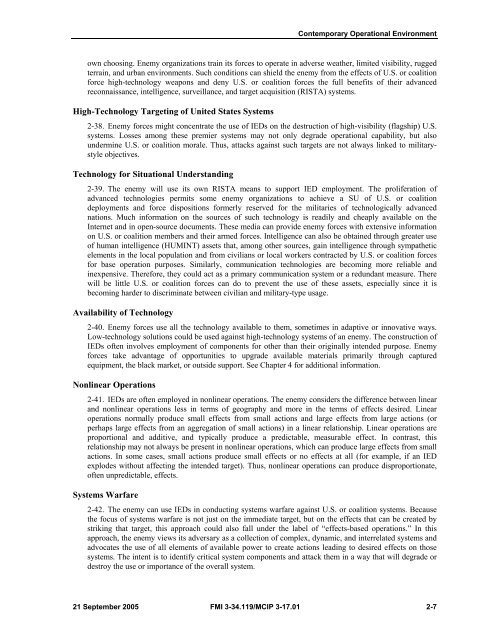FMI 3-34.119 - Soldier Support Institute - U.S. Army
FMI 3-34.119 - Soldier Support Institute - U.S. Army
FMI 3-34.119 - Soldier Support Institute - U.S. Army
You also want an ePaper? Increase the reach of your titles
YUMPU automatically turns print PDFs into web optimized ePapers that Google loves.
Contemporary Operational Environmentown choosing. Enemy organizations train its forces to operate in adverse weather, limited visibility, ruggedterrain, and urban environments. Such conditions can shield the enemy from the effects of U.S. or coalitionforce high-technology weapons and deny U.S. or coalition forces the full benefits of their advancedreconnaissance, intelligence, surveillance, and target acquisition (RISTA) systems.High-Technology Targeting of United States Systems2-38. Enemy forces might concentrate the use of IEDs on the destruction of high-visibility (flagship) U.S.systems. Losses among these premier systems may not only degrade operational capability, but alsoundermine U.S. or coalition morale. Thus, attacks against such targets are not always linked to militarystyleobjectives.Technology for Situational Understanding2-39. The enemy will use its own RISTA means to support IED employment. The proliferation ofadvanced technologies permits some enemy organizations to achieve a SU of U.S. or coalitiondeployments and force dispositions formerly reserved for the militaries of technologically advancednations. Much information on the sources of such technology is readily and cheaply available on theInternet and in open-source documents. These media can provide enemy forces with extensive informationon U.S. or coalition members and their armed forces. Intelligence can also be obtained through greater useof human intelligence (HUMINT) assets that, among other sources, gain intelligence through sympatheticelements in the local population and from civilians or local workers contracted by U.S. or coalition forcesfor base operation purposes. Similarly, communication technologies are becoming more reliable andinexpensive. Therefore, they could act as a primary communication system or a redundant measure. Therewill be little U.S. or coalition forces can do to prevent the use of these assets, especially since it isbecoming harder to discriminate between civilian and military-type usage.Availability of Technology2-40. Enemy forces use all the technology available to them, sometimes in adaptive or innovative ways.Low-technology solutions could be used against high-technology systems of an enemy. The construction ofIEDs often involves employment of components for other than their originally intended purpose. Enemyforces take advantage of opportunities to upgrade available materials primarily through capturedequipment, the black market, or outside support. See Chapter 4 for additional information.Nonlinear Operations2-41. IEDs are often employed in nonlinear operations. The enemy considers the difference between linearand nonlinear operations less in terms of geography and more in the terms of effects desired. Linearoperations normally produce small effects from small actions and large effects from large actions (orperhaps large effects from an aggregation of small actions) in a linear relationship. Linear operations areproportional and additive, and typically produce a predictable, measurable effect. In contrast, thisrelationship may not always be present in nonlinear operations, which can produce large effects from smallactions. In some cases, small actions produce small effects or no effects at all (for example, if an IEDexplodes without affecting the intended target). Thus, nonlinear operations can produce disproportionate,often unpredictable, effects.Systems Warfare2-42. The enemy can use IEDs in conducting systems warfare against U.S. or coalition systems. Becausethe focus of systems warfare is not just on the immediate target, but on the effects that can be created bystriking that target, this approach could also fall under the label of “effects-based operations.” In thisapproach, the enemy views its adversary as a collection of complex, dynamic, and interrelated systems andadvocates the use of all elements of available power to create actions leading to desired effects on thosesystems. The intent is to identify critical system components and attack them in a way that will degrade ordestroy the use or importance of the overall system.21 September 2005 <strong>FMI</strong> 3-<strong>34.119</strong>/MCIP 3-17.01 2-7
















